

Vreeken's Zaden. How to Grow Melons. The succulent flavor of vine-ripened melons is worth the special effort it takes to grow them.
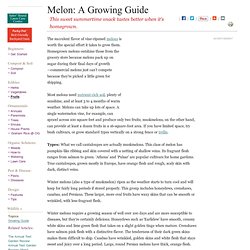
Homegrown melons outshine those from the grocery store because melons pack up on sugar during their final days of growth—commercial melons just can’t compete because they’re picked a little green for shipping. Most melons need nutrient-rich soil, plenty of sunshine, and at least 3 to 4 months of warm weather. Melons can take up lots of space. A single watermelon vine, for example, can sprawl across 100 square feet and produce only two fruits; muskmelons, on the other hand, can provide at least a dozen fruits in a 16-square-foot area.
If you have limited space, try bush cultivars, or grow standard types vertically on a strong fence or trellis. Types: What we call cantaloupes are actually muskmelons. Winter melons (also a type of muskmelon) ripen as the weather starts to turn cool and will keep for fairly long periods if stored properly. Dwarf Citrus Trees, Meyer Lemon, Kieffer Lime, Oranges - Order Online - Four Winds Growers. Blueberry, Top Hat Fruit Plants at Burpee. How to Grow Blueberries: Organic Gardening. I grow a slew of both common and uncommon fruits, from apples to kiwis to pears to paw-paws.
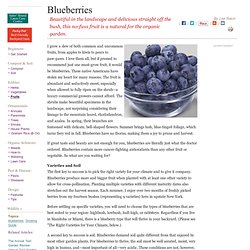
I love them all, but if pressed to recommend just one must-grow fruit, it would be blueberries. These native Americans have stolen my heart for many reasons. The fruit is abundant and seductively sweet, especially when allowed to fully ripen on the shrub—a luxury commercial growers cannot afford. The shrubs make beautiful specimens in the landscape, not surprising considering their lineage to the mountain laurel, rhododendron, and azalea. In spring, their branches are festooned with delicate, bell-shaped flowers. If great taste and beauty are not enough for you, blueberries are literally just what the doctor ordered. Varieties and Soil The first key to success is to pick the right variety for your climate and to give it company. A second key to success is soil. Framboos. De framboos (Rubus idaeus) is een plant uit de rozenfamilie.

De soort behoort evenals de gewone braam (Rubus fruticosus) tot het geslacht Rubus. Tot dit geslacht behoren meer dan zeshonderd soorten. De plant is een heester waarvan de stengels tot 2 meter lang kunnen worden. Elk jaar worden nieuwe stengels uit wortelopslag gevormd. Bij de zomerframboos dragen alleen de tweejarige stengels vrucht, waarna deze afsterven. Papaja. Common fig. Description[edit] It is a gynodioecious (functionally dioecious),[3] deciduous tree or large shrub, growing to a height of 7–10 metres (23–33 ft), with smooth white bark.
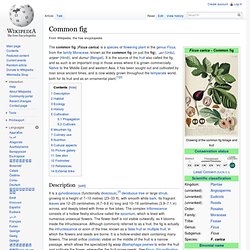
Its fragrant leaves are 12–25 centimetres (4.7–9.8 in) long and 10–18 centimetres (3.9–7.1 in) across, and deeply lobed with three or five lobes. The complex inflorescence consists of a hollow fleshy structure called the syconium, which is lined with numerous unisexual flowers. The flower itself is not visible outwardly, as it blooms inside the infructescence. Although commonly referred to as a fruit, the fig is actually the infructescence or scion of the tree, known as a false fruit or multiple fruit, in which the flowers and seeds are borne. The edible fruit consists of the mature syconium containing numerous one-seeded fruits (druplets).[3] The fruit is 3–5 centimetres (1.2–2.0 in) long, with a green skin, sometimes ripening towards purple or brown. Habitat[edit] Variegated fig Leaves and immature fruit of common fig. Garden strawberry. The garden strawberry was first bred in Brittany, France, in the 1750s via a cross of Fragaria virginiana from eastern North America and Fragaria chiloensis, which was brought from Chile by Amédée-François Frézier in 1714.[1] Cultivars of Fragaria × ananassa have replaced, in commercial production, the woodland strawberry (Fragaria vesca), which was the first strawberry species cultivated in the early 17th century.[2] History Fragaria × ananassa 'Gariguette,' a cultivar grown in southern France The first garden strawberry was grown in France during the late 18th century.[2] Prior to this, wild strawberries and cultivated selections from wild strawberry species were the common source of the fruit.
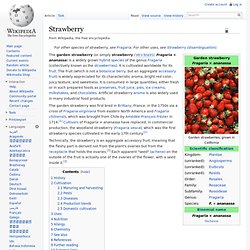
The strawberry fruit was mentioned in ancient Roman literature in reference to its medicinal use. The French began taking the strawberry from the forest to their gardens for harvest in the 1300s. Blueberry. Blueberries are usually erect.

Prostrate shrubs can vary in size from 10 centimeters (3.9 in) to 4 meters (13 ft) in height. In the commercial production of blueberries, the smaller species are known as "low-bush blueberries" (synonymous with "wild"), while the larger species are known as "high-bush blueberries". Gooseberry. The gooseberry (/ˈɡuːsbɛri/ or /ˈɡuːzbɛri/ (American) or /ˈɡʊzbəri/ (British)),[1] with scientific names Ribes uva-crispa (and syn.
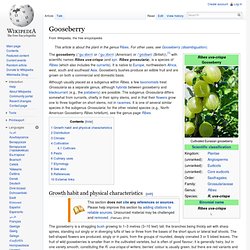
Ribes grossularia), is a species of Ribes (which also includes the currants). It is native to Europe, northwestern Africa, west, south and southeast Asia.